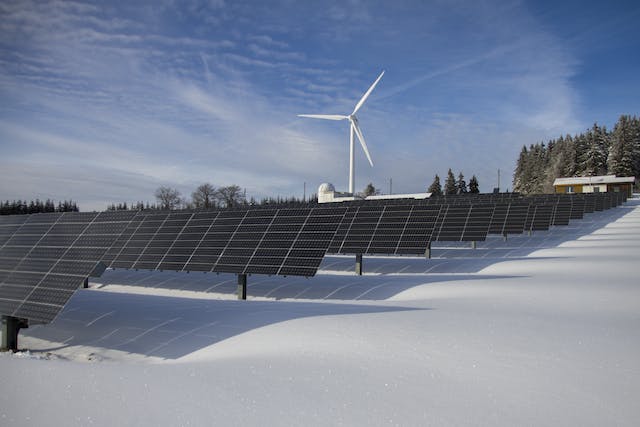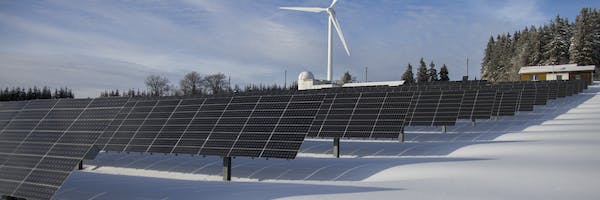
CLIMATE ACTION
Climate action involves addressing climate change by reducing greenhouse gas emissions, increasing renewable energy adoption, improving energy efficiency, conserving natural resources, and enhancing resilience. By integrating SOPTICS with ArcGIS aerial imagery, organizations can effectively monitor climate action goals, gather relevant environmental data, and establish logical intervention frameworks. This enables them to measure progress in addressing climate change and align environmental objectives with overall development goals. The system can track indicators such as greenhouse gas emissions, energy consumption, waste generation, water usage, renewable energy adoption, carbon footprint, and sustainability certifications.
Read More
DISASTER MANAGEMENT
Disaster management encompasses coordinating resources for emergencies to minimize their impact on communities and individuals. organizations can systematically monitor disaster management goals by leveraging SOPTICS and ArcGIS aerial imagery. This includes tracking indicators such as early warning system effectiveness, response time, infrastructure resilience, community preparedness, and post-disaster recovery progress. Additionally, the system facilitates the integration of disaster management interventions, monitoring risk reduction measures, emergency response drills, evacuation planning, infrastructure maintenance, and community resilience programs. This comprehensive approach enhances disaster preparedness while effectively evaluating the impact of interventions.
Read More
CIRCULAR ECONOMY
A circular economy is one of the essential areas that creates an economic system to eliminate waste and promote the continual use of resources. It focuses on reducing, reusing, recycling, and remanufacturing to create a closed-loop system where products, materials, and resources are used efficiently and sustainably. Using SOPTICS, organizations can systematically track circular economy goals in alignment with project management theory steps. This includes monitoring indicators such as waste reduction, material reuse, recycling rates, remanufacturing activities, sustainable sourcing, and eco-friendly product design. Additionally, the system facilitates the integration of circular economy interventions, allowing for tracking indicators such as resource efficiency, product life cycle analysis, supply chain sustainability, and closed-loop system performance. This comprehensive approach enables organizations to advance circular economy initiatives while measuring their impact and progress effectively.
Read More
BLUE ECONOMY
The blue economy refers to the sustainable use of ocean resources for economic growth, improved livelihoods, and jobs while preserving the health of ocean ecosystems. It encompasses various sectors such as fisheries, aquaculture, tourism, renewable energy, marine transportation, and coastal development, focusing on environmental sustainability and social inclusivity. Using SOPTICS, organizations can systematically track blue economy goals in alignment with project management theory steps. This includes monitoring indicators such as sustainable fisheries management, marine biodiversity conservation, coastal tourism development, ocean energy production, aquaculture sustainability, and marine transportation efficiency. Additionally, the system facilitates the integration of blue economy interventions, allowing for tracking indicators such as marine pollution reduction, marine spatial planning, maritime safety measures, blue technology innovation, and economic benefits for coastal communities. This comprehensive approach enables organizations to advance blue economy initiatives while measuring their impact and progress effectively.
Read More
SUSTAINABLE DEVELOPMENT
Sustainable development refers to meeting the needs of the present without compromising the ability of future generations to meet their own needs. It involves balancing economic, social, and environmental considerations to ensure long-term prosperity, equity, and integrity. Using SOPTICS, organizations can systematically track sustainable development goals in alignment with project management theory steps. This includes monitoring indicators such as renewable energy adoption, carbon emissions reduction, water and energy efficiency, waste management practices, biodiversity conservation, and social impact assessments. Additionally, the system facilitates the integration of sustainable development interventions, tracking indicators such as community empowerment programs, eco-friendly initiatives, green infrastructure projects, fair trade practices, and sustainable supply chain management. This comprehensive approach enables organizations to advance sustainable development initiatives while measuring their impact and progress effectively.
Read More
DIVERSITY AND INCLUSION
Diversity and inclusion refer to creating environments where differences are valued and respected. It involves recognising, appreciating, and leveraging individuals' unique backgrounds, perspectives, and experiences to create a more equitable and inclusive society or organization. Using SOPTICS, organizations can systematically track diversity and inclusion goals in alignment with project management theory steps. This includes monitoring indicators such as workforce diversity representation, equitable hiring practices, employee satisfaction surveys, leadership diversity, cultural competency training participation, and promotion rates among diverse groups. Additionally, the system facilitates the integration of diversity and inclusion interventions, tracking indicators such as mentorship program effectiveness, diversity training impact, bias incident reporting, employee resource group activities, and inclusive policy implementation. This comprehensive approach enables organizations to advance diversity and inclusion initiatives while effectively measuring their impact and progress.
Read More
RENEWABLE ENERGY
Renewable energy is derived from naturally replenishing sources, such as sunlight, wind, rain, tides, waves, and geothermal heat. Unlike fossil fuels, renewable energy sources are sustainable and have a lower environmental impact, making them a key component of efforts to reduce carbon emissions and combat climate change. Using SOPTICS, organizations can systematically track renewable energy goals in alignment with project management theory steps. This includes monitoring indicators such as solar panel installation, wind turbine efficiency, biomass energy production, hydropower capacity, geothermal energy utilization, and energy storage system implementation. Additionally, the system facilitates the integration of renewable energy interventions, allowing for tracking indicators such as carbon emissions reduction, energy cost savings, grid integration feasibility, renewable energy certificates, and public awareness campaigns. This comprehensive approach enables organizations to advance renewable energy initiatives while measuring their impact and progress effectively.
Read More













SOCIAL WELFARE
Social welfare refers to the well-being of individuals, families, and communities. It encompasses a range of programs, services, and policies designed to promote economic security, access to healthcare, education, housing, and social support for those in need. Social welfare aims to enhance the quality of life and opportunities for all members of society. Using SOPTICS, organizations can systematically track social welfare goals in alignment with project management theory steps. This includes monitoring indicators such as access to education, healthcare utilization, poverty alleviation programs, employment opportunities, housing stability, and community engagement levels. Additionally, the system facilitates the integration of social welfare interventions, tracking indicators such as job training program outcomes, healthcare outreach effectiveness, educational attainment rates, affordable housing initiatives, social service utilization, and volunteer participation. This comprehensive approach enables organizations to advance social welfare initiatives while measuring their impact and progress effectively.
Read More